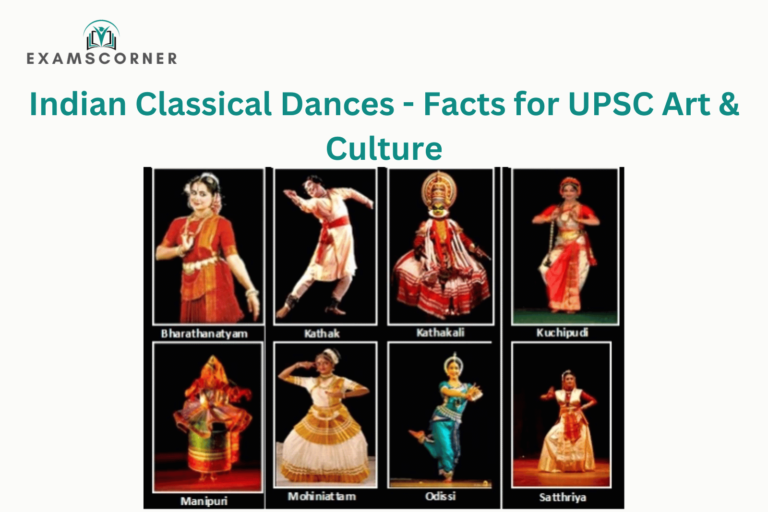Bharat Muni’s book Natya Shastra is the first famous source to mention dance. India has various forms of dances including classical dances and folk dances. Knowing about Indian Classical Dances is important for the IAS Exam, as it holds importance for the Art & Culture syllabus of GS-I.
What are the 8 Classical Dances of India?
The table below mentions the eight classical dances of India:
| Indian Classical Dances | ||
| S.No | Name of Classical Dance | Place of Classical Dance |
| 1 | Bharatanatyam | Tamil Nadu |
| 2 | Kathak | Northern India |
| 3 | Kathakali | Kerala |
| 4 | Kuchipudi | Andhra Pradesh |
| 5 | Manipuri | Manipur |
| 6 | Mohiniyattam | Kerala |
| 7 | Odissi | Odisha |
| 8 | Sattriya | Assam |
What are the aspects of Classical Dance?
The facts about related to the aspects of Classical Dance are mentioned in the table below:
| Indian Classical Dances | |
| What are the two basic aspects of Classical Dance? | There are two basic aspects of Natya Shastra: 1. Lasya 2. Tandava |
| What is Lasya? | It denotes grace, bhava, rasa and abhinaya. It is symbolic to the feminine features of dance as an art form |
| What is Tandava? | This is symbolic to the male aspects of dance and has more emphasis on rhythm and movement |
| What are the three basic elements of a classical dance act? | There are three basic elements: 1. Nritta – These are the basic dance steps and are performed rhythmically but devoid of any expression or mood 2. Natya – It means dramatic representations and refers to the story that is elaborated through the dance recital 3. Nritya – refers to the sentiment and the emotions evoked through dance. It includes the mime and the different methods of expression including mudras in the dance |
| What is Guru-Shishya Paramapara? | It forms the core of the Indian Classical Dance forms. The basic meaning is that each dance form is related to a Guru (Teacher) and he/she transfers that knowledge of dance to a Shishya (Student.) |
9 Rasa of Classical Dance
There nine rasas of the classical dances are:
| Classical Dance – 9 Rasas | |
| Rasas | Attributes |
| Shringaara | Love |
| Roudra | Anger |
| Bibhatsa | Disgust |
| Veera | Heroism |
| Shaant | Peace and Tranquility |
| Hasya | Laughter and Comedy |
| Karuna | Tragedy |
| Bhayanak | Horror |
| Adbhuta | Wonder |
Indian Classical Dance – Chhau
Sangeet Natak Academy (India’s National Academy) recognizes only eight classical dances of India, however, the Ministry of Culture also considers Chhau Dance as a classical dance of India, making the total number of classical dances in India as nine.
A few important points on Chhau Dance are as mentioned:
- The word ‘Chaya’ gives meaning to Chhau Dance. Chaya means shadow.
- As a mask dance, Chhau dance is denoted.
- Energetic martial art movements are basic feature of Chhau Dance
- Serpent Dance, Peacock Dance are a few narrations used in Chhau Dance
- There are three kinds of Chhau Dance:
- Saraikella – This Chhau Dance is famous in Jharkhand
- Mayurbhanj – This Chhau Dance is famous in Odisha
- Purulia – This Chhau Dance is famous in West Bengal
- Mayurbhanj Chhau Dance does not use masks.
- Chhau Dance was inscribed in the UNESCO’s Representative List of Intangible Cultural Heritage of Humanity



